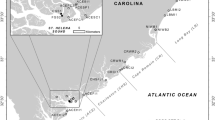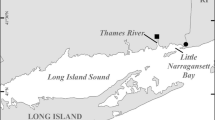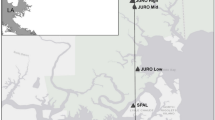Abstract
Salt marshes persist within the intertidal zone when marsh elevation gains are commensurate with rates of sea-level rise (SLR). Monitoring changes in marsh elevation in concert with tidal water levels is therefore an effective way to determine if salt marshes are keeping pace with SLR over time. Surface elevation tables (SETs) are a common method for collecting precise data on marsh elevation change. Southern New England is a hot spot for SLR, but few SET elevation change datasets are available for the region. Our study synthesizes elevation change data collected from 1999 to 2015 from a network of SET stations throughout Rhode Island (RI). These data are compared to accretion and water level data from the same time period to estimate shallow subsidence and determine whether marshes are tracking SLR. Salt marsh elevation increased at a mean overall rate of 1.40 mm year−1 and ranged from −0.33 to 3.36 mm year−1 at individual stations. Shallow subsidence dampened elevation gain in mid-Narragansett Bay marshes, but in other areas of coastal RI, subsurface processes may augment surface accretion. In all cases, marsh elevation gain was exceeded by the 5.26 mm year−1 rate of increase in sea levels during the study period. Our study provides the first SET elevation change data from RI and shows that most RI marshes are not keeping pace with short- or long-term rates of SLR. It also lends support to previous research that implicates SLR as a primary driver of recent changes to southern New England salt marshes.



Similar content being viewed by others
References
Alber M, Swenson EM, Adamowicz SC, Mendelssohn IA (2008) Salt marsh dieback: an overview of recent events in the US. Estuar Coast Shelf Sci 80:1–11. doi:10.1016/j.ecss.2008.08.009
Alizad K, Hagen SC, Morris JT, Bacopoulos P, Bilskie MV, Weishampel JF, Medeiros SC (2016) A coupled, two-dimensional hydrodynamic-marsh model with biological feedback. Ecol Model 327:29–43. doi:10.1016/j.ecolmodel.2016.01.013
Anisfeld SC, Hill TD (2012) Fertilization effects on elevation change and belowground carbon balance in a Long Island Sound tidal marsh. Estuar Coast 35:201–211. doi:10.1007/s12237-011-9440-4
Anisfeld SC, Hill TD, Cahoon DR (2016) Elevation dynamics in a restored versus a submerging salt marsh in Long Island Sound. Estuar Coast Shelf Sci 170:145–154. doi:10.1016/j.ecss.2016.01.017
Bricker-Urso S, Nixon SW, Cochran JK, Hirschberg DJ, Hunt C (1989) Accretion rates and sediment accumulation in Rhode Island salt marshes. Estuar 12:300–317. doi:10.2307/1351908
Burdick DM, Peter CR (2015) Using sediment elevation tables (SETs) to analyze recent changes in surface elevation of New Hampshire salt marshes. Final report prepared for New Hampshire Department of Environmental Services: New Hampshire Coastal Program, Portsmouth, p 22
Cahoon DR, Guntenspergen GR (2010) Climate change, sea-level rise, and coastal wetlands. Natl Wetl Newsl 32:8–12
Cahoon DR, Reed DJ, Day JW Jr (1995) Estimating shallow subsidence in microtidal salt marshes of the southeastern United States: Kaye and Barghoorn revisited. Mar Geol 128:1–9. doi:10.1016/0025-3227(95)00087-f
Cahoon DR, Lynch JC, Hensel P, Boumans R, Perez BC, Segura B, Day JW Jr (2002a) High-precision measurements of wetland sediment elevation: I. Recent improvements to the sedimentation-erosion table. J Sediment Res 72:730–733. doi:10.1306/020702720730
Cahoon DR, Lynch JC, Perez BC, Segura B, Holland R, Stelly C, Stephenson G, Hensel P (2002b) High-precision measurements of wetland sediment elevation: II. The rod surface elevation table. J Sediment Res 72:734–739. doi:10.1306/020702720734
Carey JC, Raposa KB, Wigand C, Warren RS (2015a) Contrasting decadal-scale changes in elevation and vegetation in two Long Island Sound salt marshes. Estuar Coast. doi:10.1007/s12237-015-0059-8 (advance online publication)
Carey JC, Moran SB, Kelly RP, Kolker AS, Fulweiler RW (2015b) The declining role of organic matter in New England salt marshes. Estuar Coast. doi:10.1007/s12237-015-9971-1 (advance online publication)
Cole Ekberg M, Ferguson W, Raposa K (2015) Results of the 1st Rhode Island salt marsh assessment: final report. Final report to the Rhode Island Coastal and Estuarine Habitat Restoration Trust Fund. p 38
Cottam C (1938) The coordination of mosquito control with wildlife conservation. N J Mosq Exterm Assoc Proc 25:217–227. doi:10.5962/bhl.title.67882
Craft C, Clough J, Ehman J, Joye S, Park R, Pennings S, Guo H, Machmuller M (2009) Forecasting the effects of accelerated sea level rise on tidal marsh ecosystem services. Front Ecol Environ 7:73–78. doi:10.1890/070219
DeLaune RD, Nyman JA, Patrick WH Jr (1994) Peat collapse, ponding and wetland loss in a rapidly submerging coastal marsh. J Coastal Res 10:1021–1030
Donnelly JP, Bertness MD (2001) Rapid shoreward encroachment of salt marsh cordgrass in response to accelerated sea level rise. Proc Natl Acad Sci 98:14218–14223. doi:10.1073/pnas.251209298
Erwin RM, Cahoon DR, Prosser DJ, Sanders GM, Hensel P (2006) Surface elevation dynamics in vegetated Spartina marshes versus unvegetated tidal ponds along the mid-Atlantic coast, USA, with implications to waterbirds. Estuar Coast 29:96–106. doi:10.1007/bf02784702
Fagherazzi S, Kirwan ML, Mudd SM, Guntenspergen GR, Temmerman S, D’Alpaos A, van de Koppel J, Rybczyk JM, Reyes E, Craft C, Clough J (2012) Numerical models of salt marsh evolution: ecological, geomorphic, and climatic factors. Rev Geophys. doi:10.1029/2011rg000359
Hartig EK, Gornitz V, Kolker A, Mushacke F, Fallon D (2002) Anthropogenic and climate-change impacts on salt marshes of Jamaica Bay, New York City. Wetlands 22:71–89. doi:10.1672/0277-5212(2002)022[0071:AACCIO]2.0.CO;2
Kennish MJ (2001) Coastal salt marsh systems in the US: a review of anthropogenic impacts. J Coast Res 17:731–748
Kirwan ML, Megonigal JP (2013) Tidal wetland stability in the face of human impacts and sea level rise. Nature 504:53–60. doi:10.1038/nature12856
Kirwan ML, Mudd SM (2012) Response of salt-marsh carbon accumulation to climate change. Nature 489:550–554. doi:10.1038/nature11440
Kirwan ML, Guntenspergen GR, D’Alpaos A, Morris JT, Mudd SM, Temmerman S (2010) Limits on the adaptability of coastal marshes to rising sea level. Geophys Res Lett 37:L23401. doi:10.1029/2010GL045489
Lynch JC, Hensel P, Cahoon DR (2015) The surface elevation table and marker horizon technique: a protocol for monitoring wetland elevation dynamics. Natural Resource Report NPS/NCBN/NRR—2015/1078. Fort Collins, National Park Service
McKinney RA, Wigand C (2006) A framework for the assessment of the wildlife habitat value of New England salt marshes. EPA/600/R-06/132. Office of Research and Development, Washington
Miller WR, Egler FE (1950) Vegetation of the Wequetequock-Pawcatuck tidal-marshes, Connecticut. Ecol Monogr 20:143–172. doi:10.2307/1943548
Nicholls RJ, Cazenave A (2010) Sea-level rise and its impact on coastal zones. Science 328:1517–1520. doi:10.1126/science.1185782
Oczkowski A, Nixon S, Henry K, DiMilla P, Pilson M, Granger S, Buckley B, Thornber C, McKinney R, Chaves J (2008) Distribution and trophic importance of anthropogenic nitrogen in Narragansett Bay: an assessment using stable isotopes. Estuar Coast 31:53–69. doi:10.1007/s12237-007-9029-0
Orson RA, Warren RS, Niering WA (1998) Interpreting sea level rise and rates of vertical marsh accretion in a southern New England tidal salt marsh. Estuar Coast Shelf Sci 47:419–429. doi:10.1006/ecss.1998.0363
Raposa KB, Weber RLJ, Ekberg MC, Ferguson W (2015) Vegetation dynamics in Rhode Island salt marshes during a period of accelerating sea level rise and extreme sea level events. Estuar Coast. doi:10.1007/s12237-015-0018-4 (advance online publication)
Raposa KB, Kutcher T, Ferguson W, Ekberg MC, Weber RLJ (2016) A strategy for developing a salt marsh monitoring and assessment program for the State of Rhode Island. Final report to the Rhode Island Department of Environmental Management and the Rhode Island Coastal Resources Management Council. p 27
RI Coastal Resources Management Council (2015) The Rhode Island Sea Level Affecting Marshes Model (SLAMM) project: Summary report. p 25
Roman CT, Peck JA, Allen JR, King JW, Appleby PG (1997) Accretion of a New England (U.S.A.) salt marsh in response to inlet migration, storms, and sea-level rise. Estuar Coast Shelf Sci 45:717–727. doi:10.1006/ecss.1997.0236
Rozas LP, Reed DJ (1993) Nekton use of marsh-surface habitats in Louisiana (USA) deltaic salt marshes undergoing submergence. Mar Ecol Prog Ser 96:147–157. doi:10.3354/meps096147
Sallenger AH, Doran KS, Howd PA (2012) Hotspot of accelerated sea level rise on the Atlantic coast of North America. Nature Clim Change 2:884–888. doi:10.1038/nclimate1597
Shepard CC, Crain CM, Beck MW (2011) The protective role of coastal marshes: a systematic review and meta-analysis. PLoS ONE 6(11):e27374. doi:10.1371/journal.pone.0027374
Valiela I, Cole ML (2002) Comparative evidence that salt marshes and mangroves may protect seagrass meadows from land-derived nitrogen loads. Ecosystems 5:92–102. doi:10.1007/s10021-001-0058-4
Vincent RE, Burdick DM, Dionne M (2013) Ditching and ditch-plugging in New England salt marshes: effects on hydrology, elevation, and soil characteristics. Estuar Coast 36:610–625. doi:10.1007/s12237-012-9583-y
Watson EB, Oczkowski AJ, Wigand C, Hanson AR, Davey EW, Crosby SC, Johnson RL, Andrews HM (2014a) Nutrient enrichment and precipitation changes do not enhance resiliency of salt marshes to sea level rise in the northeastern U.S. Clim Change 125:501–509. doi:10.1007/s10584-014-1189-x
Watson EB, Wigand C, Andrews HM, Moran SB (2014b) Pettaquamscutt Cove Salt Marsh: environmental conditions and historical ecological change. National Health and Environmental Effects Research Laboratory, Atlantic Ecology Division contribution number ORD-007757 prepared for the Narrow River Restoration Committee. p 15
Watson EB, Wigand C, Davey EW, Andrews HM, Bishop J (2016) Wetland loss patterns and inundation-productivity relationships prognosticate widespread salt marsh loss for southern New England. Estuar Coast. doi:10.1007/s12237-016-0069-1 (advance online publication)
Webb EL, Friess DA, Krauss KW, Cahoon DR, Guntenspergen GR, Phelps J (2013) A global standard for monitoring coastal wetland vulnerability to accelerated sea-level rise. Nat Clim Change 3:458–465. doi:10.1038/nclimate1756
Weston NB (2014) Declining sediments and rising seas: an unfortunate convergence for tidal wetlands. Estuar Coast 37:1–23. doi:10.1007/s12237-013-9654-8
Wright S (2012) Understanding the mechanisms behind surface elevation loss in ditched marshes. M.S. Thesis, Boston University
Acknowledgments
We would like to thank all the staff, students, and volunteers who helped install and read SETs and marker horizons across the RI network. In particular, this includes James Lynch, Robin Weber, Daisy Durant, Erin King, Rhonda Smith, Benjamin Gaspar, Jennifer White, Kevin Rogers, Dr. Larry Ward, and Alison Bowden. We would also like to thank Robin Weber for creating Fig. 1, Philippe Hensel for advice on SET data analysis and interpretation, Elizabeth Watson for guidance on manuscript preparation, and Jordan Mora for SET elevation change data from the Waquoit Bay National Estuarine Research Reserve. Financial support was provided in part by a grant under the Federal Coastal Zone Management Act, administered by the Office of Ocean and Coastal Management, National Oceanic and Atmospheric Administration, Silver Spring, MD. Additional funding was provided by the U.S. Fish and Wildlife Service LMRD program, Inventory and Monitoring effort and the Hurricane Sandy DOI #30 “Stronger Coast” project. The findings and conclusions in this article are those of the author(s) and do not necessarily represent the views of the US Fish and Wildlife Service.
Author information
Authors and Affiliations
Corresponding author
Ethics declarations
Conflict of interest
The authors declare that they have no conflict of interest.
Additional information
Editor: Erica Smithwick.
Electronic supplementary material
Below is the link to the electronic supplementary material.
Rights and permissions
About this article
Cite this article
Raposa, K.B., Cole Ekberg, M.L., Burdick, D.M. et al. Elevation change and the vulnerability of Rhode Island (USA) salt marshes to sea-level rise. Reg Environ Change 17, 389–397 (2017). https://doi.org/10.1007/s10113-016-1020-5
Received:
Accepted:
Published:
Issue Date:
DOI: https://doi.org/10.1007/s10113-016-1020-5




